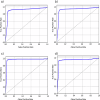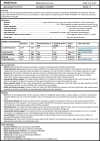Evaluating sepsis watch generalizability through multisite external validation of a sepsis machine learning model
- PMID: 40500319
- PMCID: PMC12159134
- DOI: 10.1038/s41746-025-01664-5
Evaluating sepsis watch generalizability through multisite external validation of a sepsis machine learning model
Abstract
Sepsis accounts for a substantial portion of global deaths and healthcare costs. The objective of this reproducibility study is to validate Duke Health's Sepsis Watch ML model, in a new community healthcare setting and assess its performance and clinical utility in early sepsis detection at Summa Health's emergency departments. The study analyzed the model's ability to predict sepsis using a combination of static and dynamic patient data using 205,005 encounters between 2020 and 2021 from 101,584 unique patients. 54.7% (n = 112,223) patients were female and the average age was 50 (IQR [38,71]). The AUROC ranged from 0.906 to 0.960, and the AUPRC ranged from 0.177 to 0.252 across the four sites. Ultimately, the reproducibility of the Sepsis Watch model in a community health system setting confirmed its strong and robust performance and portability across different geographical and demographic contexts with little variation.
© 2025. The Author(s).
Conflict of interest statement
Competing interests: W.R. reported writing software licensed to Fullsteam Health. M.Gao reported writing software licensed to Clinetic, Cohere Med, and Fullsteam Health. M.Gao reported owning equity in Clinetic. M. Gardner reported writing software licensed to Fullsteam Health. M.N. reported writing software licensed to Clinetic, Cohere Med, and Fullsteam Health. M.N. reported owning equity in Clinetic. M.R. reported writing software licensed to Clinetic, Cohere Med, and Fullsteam Health. M.R. reported owning equity in Clinetic. M.P. reported receiving grants from HeartFlow, Bayer, Janssen, and Novartis outside the submittedwork. S.B. reported writing software licensed to Clinetic, Cohere Med, and Fullsteam Health. SB reported owning equity in Clinetic. M.S. reported writing software licensed to Clinetic, Cohere Med, KelaHealth, and Fullsteam Health. M.S. reported owning equity in Clinetic. M.S. and S.B reported receiving grants from the Gordon and Betty Moore Foundation and the PatrickJ McGovern Foundation. No other disclosures were reported.
Figures



References
Grants and funding
LinkOut - more resources
Full Text Sources

